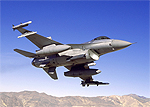Pilots, crews practice combat skills at Red Flag Alaska
 Airmen are testing their mettle at Red Flag Alaska 2016, a series of four Pacific Air Forces training exercises held at Eielson Air Force Base and Joint Base Elmendorf-Richardson, Alaska, that bring together pilots from across the U.S. military and allied nations. The second of the four exercises ended June 17, with the next portion scheduled to begin August 4.
Airmen are testing their mettle at Red Flag Alaska 2016, a series of four Pacific Air Forces training exercises held at Eielson Air Force Base and Joint Base Elmendorf-Richardson, Alaska, that bring together pilots from across the U.S. military and allied nations. The second of the four exercises ended June 17, with the next portion scheduled to begin August 4.
"The whole purpose of Red Flags is to learn the hard lessons in a safe spot instead of in combat," said Capt. Lloyd Wright, one of the pilots helping to organize and run the event. "There’s no such thing as a perfect sortie for anyone. It’s been a steady learning curve, positive improvement across the board."
First held in Alaska in 1992, the exercise was known as "Cope Thunder" until it was renamed in 2006 to match the Air Force's famous Red Flag training exercise at Nellis Air Force Base, Nevada.
The event deploys more than 1,000 people and 60 aircraft to Eielson and 500 people with 40 aircraft to Joint Base Elmendorf-Richardson. According to officials at Eielson, up to 70 jets can be in the same airspace at once during the height of the exercise, which takes place at the more than 67,000 square-mile Joint Pacific Range Complex over Alaska and parts of western Canada.
Wright said it's the largest number of participants they've had in the past five years, and includes teams from the Army and Marine Corps as well as international partners like Japan, India and Singapore.
According to a statement from Eielson, Red Flag was designed to sharpen and hone pilots' and crews' combat edge.
"Prior to Operation Desert Storm, less than one-fifth of the U.S. Air Force's primary fighter pilots had seen actual combat," a statement from Eielson said. "While the percentage of combat-experienced pilots has increased in recent years, at the time, a high percentage of pilots had no combat experience. Analysis indicates most combat losses occur during an aircrew's first eight to 10 missions. Therefore, the goal of Red Flag Alaska is to provide each aircrew with these first vital missions, increasing their chances of survival in combat environments."
Wright is in charge of ensuring that surface-to-air missile threats are realistic for the training exercise, and he also flies an F-15E Strike Eagle as an "aggressor" pilot against the participants.
"The most important thing for airmen, for everyone to take away is what their part in the big war is," he said. "It is an opportunity to see all the pieces work together, how squadrons and coalition partners all work together in a bigger picture."
The goal is to create a realistic training environment with a variety of targets and threats and a full spectrum of missions ranging from personnel recovery to penetrating an area with heavy anti-air defenses, Wright said. The biggest challenge is "making sure that we are giving the best training possible and not wasting anyone’s time [and] capitalize on every second we have in the air."
For his part, Wright said he's enjoyed seeing all the pilots and crews work seamlessly together.
"When I got to fly as one of the aggressors and just flying training, flying at 40,000 feet, Mach 1, and getting 'shot down' by [an F-22] Raptor, [that was] my favorite thing so far," Wright said.